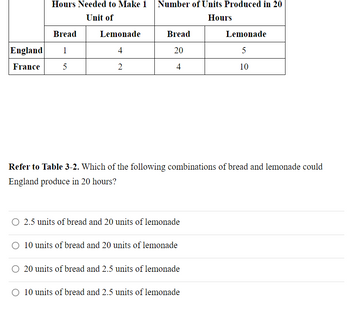
ENGR.ECONOMIC ANALYSIS
14th Edition
ISBN: 9780190931919
Author: NEWNAN
Publisher: Oxford University Press
expand_more
expand_more
format_list_bulleted
Question

Transcribed Image Text:England
France
Hours Needed to Make 1
Unit of
Bread
1
5
Lemonade
4
2
Number of Units Produced in 20
Hours
Bread
20
4
Refer to Table 3-2. Which of the following combinations of bread and lemonade could
England produce in 20 hours?
O 2.5 units of bread and 20 units of lemonade
O 10 units of bread and 20 units of lemonade
O 20 units of bread and 2.5 units of lemonade
Lemonade
5
10
O 10 units of bread and 2.5 units of lemonade
Expert Solution
arrow_forward
Step 1
The production possibility schedule shows the trade-off between the production of two goods, assuming that the resources used to produce one good cannot be used to produce the other.
The production possibility schedule is used to illustrate concepts such as opportunity cost, trade-offs, and efficient resource allocation. It is a useful tool for analyzing the production decisions of individuals, firms, and countries, and can help policymakers understand the impact of resource allocation decisions on the economy.
Trending nowThis is a popular solution!
Step by stepSolved in 3 steps

Knowledge Booster
Learn more about
Need a deep-dive on the concept behind this application? Look no further. Learn more about this topic, economics and related others by exploring similar questions and additional content below.Similar questions
- Use the table to answer the question.arrow_forwardAverage total cost tells us the O 1) cost of the last unit of output, if total cost does not include a fixed cost component. 2) variable cost of a firm that is producing at least one unit of output. 3) O 4) total cost of the first unit of output, if total cost is divided evenly over all th units produced. cost of a typical unit of output, if total cost is divided evenly over all the uni produced.arrow_forwardPlease choose answers for what happens to ppf and explanation from the dropdown shownarrow_forward
- Imagine the GDP per capita of a country doubles every one hundred years. What would the shape of a linear-scale graph and a ratio- scale graph be? Select one or more: O a. Linear scale: an upward-sloping Ratio scale: an upward-sloping curve with increasing slope (called straight line convex shape) O b. Ratio scale: a straight horizontal line Linear scale: an upward-sloping straight line Ratio scale: an upward-sloping curve with decreasing slope (called O C. Linear scale: an upward-sloping straight line concave shape) O d. Linear scale: an upward-sloping Ratio scale: an upward-sloping convex curve convex curvearrow_forwardQuestion 16 ) Listen Refer to the production possibilities curves. Curve (a) is the current curve for the economy. Focusing on curve (a), point N suggests that the economy currently produces: (a) (b) Capital Goods O a) A combination of output that is less than its potential O b) Less goods for the future than at point P O c) Less goods for the present than at point P O d) More goods for the future than at point P Question 17 ) Listen Consider an economy that is producing inside its production possibilities curve. This economy could move closer towards its production possibilities curve by: a) Distributing incomes more equally b) Acquiring additional resources c) Employing more of its available resources d) Increasing the levels of wages and prices Consumer Goodsarrow_forward33arrow_forward
- Number of Employees Total Production Marginal Product of Labor Marginal Revenue Product O 1 2 3 4 O Four employees O One employees O Three employees O OTwo employees 9 24 36 43 O 9 If the price of the item is $15.00 per unit and the employees cost $125 each, how many employees should the firm hire to maximize their profit? 15 12 7arrow_forwardQUESTION 9 In one day Amazing company produced 50 shirts in 250 labor hours, What is Amazing company's productivity? O a. 1/5 shirts per hour O b. 5 hours per shirts O C. 50 shirts d. 5 shirts.arrow_forward23arrow_forward
arrow_back_ios
arrow_forward_ios
Recommended textbooks for you

 Principles of Economics (12th Edition)EconomicsISBN:9780134078779Author:Karl E. Case, Ray C. Fair, Sharon E. OsterPublisher:PEARSON
Principles of Economics (12th Edition)EconomicsISBN:9780134078779Author:Karl E. Case, Ray C. Fair, Sharon E. OsterPublisher:PEARSON Engineering Economy (17th Edition)EconomicsISBN:9780134870069Author:William G. Sullivan, Elin M. Wicks, C. Patrick KoellingPublisher:PEARSON
Engineering Economy (17th Edition)EconomicsISBN:9780134870069Author:William G. Sullivan, Elin M. Wicks, C. Patrick KoellingPublisher:PEARSON Principles of Economics (MindTap Course List)EconomicsISBN:9781305585126Author:N. Gregory MankiwPublisher:Cengage Learning
Principles of Economics (MindTap Course List)EconomicsISBN:9781305585126Author:N. Gregory MankiwPublisher:Cengage Learning Managerial Economics: A Problem Solving ApproachEconomicsISBN:9781337106665Author:Luke M. Froeb, Brian T. McCann, Michael R. Ward, Mike ShorPublisher:Cengage Learning
Managerial Economics: A Problem Solving ApproachEconomicsISBN:9781337106665Author:Luke M. Froeb, Brian T. McCann, Michael R. Ward, Mike ShorPublisher:Cengage Learning Managerial Economics & Business Strategy (Mcgraw-...EconomicsISBN:9781259290619Author:Michael Baye, Jeff PrincePublisher:McGraw-Hill Education
Managerial Economics & Business Strategy (Mcgraw-...EconomicsISBN:9781259290619Author:Michael Baye, Jeff PrincePublisher:McGraw-Hill Education


Principles of Economics (12th Edition)
Economics
ISBN:9780134078779
Author:Karl E. Case, Ray C. Fair, Sharon E. Oster
Publisher:PEARSON

Engineering Economy (17th Edition)
Economics
ISBN:9780134870069
Author:William G. Sullivan, Elin M. Wicks, C. Patrick Koelling
Publisher:PEARSON

Principles of Economics (MindTap Course List)
Economics
ISBN:9781305585126
Author:N. Gregory Mankiw
Publisher:Cengage Learning

Managerial Economics: A Problem Solving Approach
Economics
ISBN:9781337106665
Author:Luke M. Froeb, Brian T. McCann, Michael R. Ward, Mike Shor
Publisher:Cengage Learning

Managerial Economics & Business Strategy (Mcgraw-...
Economics
ISBN:9781259290619
Author:Michael Baye, Jeff Prince
Publisher:McGraw-Hill Education